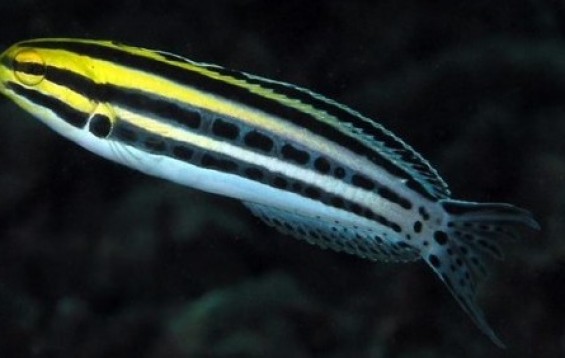- Name:
Striped Blenny
(View AKA's) - Family: Blenniidae
- Species: Blenny
- Scientific Name: Meiacanthus grammistes


Statistics
-
Difficult
Care Level
-
Aggressive
Temperament
-
Omnivore
Diet
-
0%
Reef Safe
- 77
Temp (Temperature)
- 7.9
pH (pH)
- 0.5
NH3-4 (Ammonia)
- 0
NO3 (Nitrate)
- 0.25
PO4 (Phosphate)
- 7
AT (Alkalinity)
- 500
Ca (Calcium)
- 1500
Mg (Magnesium)
- 1.026
SG (Salinity)
- NAN
ORP (Oxidation Reduction Potential)
- 0
Avg. Size (Inches)
- 75
Avg.Tank Size (Gallons)
- 1
Avg Life (Years)

Venomous
Statistics above are based off of 1
user
who have claimed.
More Details
General info about Striped Blenny
The Striped Blenny, also known as the Striped Fang Blenny or Striped Poison-Fang Blenny, is a small marine species that typically grows to around 4 cm in length. They are native to the Indo-Pacific region and are found in coral reefs and other rocky areas with plenty of hiding spots. They are a popular species in the aquarium trade due to their striking appearance and their tendency to be active and entertaining to watch.
Striped Blenny Diet & Nutrition
The Striped Blenny is a carnivorous species and feeds mainly on small crustaceans such as copepods and amphipods, as well as small worms and other invertebrates. In an aquarium setting, they can be fed a diet of frozen or live food, such as brine shrimp or mysis shrimp, along with a high-quality pellet or flake food.
Determining Sex of Striped Blenny
It can be difficult to determine the sex of the Striped Blenny. Males tend to be larger and more brightly colored than females, but this is not always a reliable indicator. The best way to determine the sex is by observing their behavior during breeding season.
Breeding & Spawning Striped Blenny
Breeding the Striped Blenny in captivity can be challenging, but it is possible with the right setup and conditions. They are a monogamous species and should be kept in pairs or small groups. Breeding usually occurs in the late afternoon or early evening, with the female laying a few dozen eggs on a suitable surface. The eggs hatch after a few days and the fry can be raised on a diet of small live foods.
Common Diseases with Striped Blenny
Breeding the Striped Blenny in captivity can be challenging, but it is possible with the right setup and conditions. They are a monogamous species and should be kept in pairs or small groups. Breeding usually occurs in the late afternoon or early evening, with the female laying a few dozen eggs on a suitable surface. The eggs hatch after a few days and the fry can be raised on a diet of small live foods.
Striped Blenny Origin
The Striped Blenny is native to the Indo-Pacific region, where it is found in coral reefs and rocky areas from the eastern coast of Africa to the western coast of the Americas.
Caution with Striped Blenny
The Striped Blenny is a venomous species and has two small fangs that can deliver a painful bite if provoked or handled. While their venom is not usually dangerous to humans, it can cause swelling, numbness, and other symptoms. It is important to handle them with care and avoid disturbing them unnecessarily.
Acclimating Striped Blenny
When introducing the Striped Blenny to a new aquarium, it is important to acclimate them slowly to the new environment. This can be done by floating the bag containing the fish in the aquarium for around 15-20 minutes, then gradually adding small amounts of water from the aquarium to the bag over the course of an hour. Once acclimated, they can be released into the aquarium.
Striped Blenny are Venomous
Relevent Articles
Original Detail
| Name | Species | Family | Scientific Name | More Detail | Added by |
|---|---|---|---|---|---|
| Striped Blenny | Blenny | Blenniidae | Meiacanthus grammistes | The Striped Blenny, also known as the Striped Fang Blenny or Striped Poison-Fang Blenny, is a small marine species that typically grows to around 4 cm in length. They are native to the Indo-Pacific region and are found in coral reefs and other rocky areas with plenty of hiding spots. They are a popular species in the aquarium trade due to their striking appearance and their tendency to be active and entertaining to watch. | PalaciosAn |
Changed by users
| Submitted Date | Submitted By | Status | Action |
|---|


